Toyota Avensis (2009-2015) Review
Written by Andrew Brady
Quick overview
Pros
- Practical, in both saloon and estate form
- Refined, quiet and comfortable on the move
- Excellent 2.0 diesel engine that’s both punchy and efficient
Cons
- Dull styling and lacklustre image
- Driving experience lacks sparkle
- The interior lacks quality
Overall verdict
"If Toyota set out to build a safe, robust, practical, comfortable and reliable car, it can consider the Avensis to be a job well done. It’s utterly forgettable to drive and to look at, but the no-nonsense and no-frills approach is surprisingly appealing."
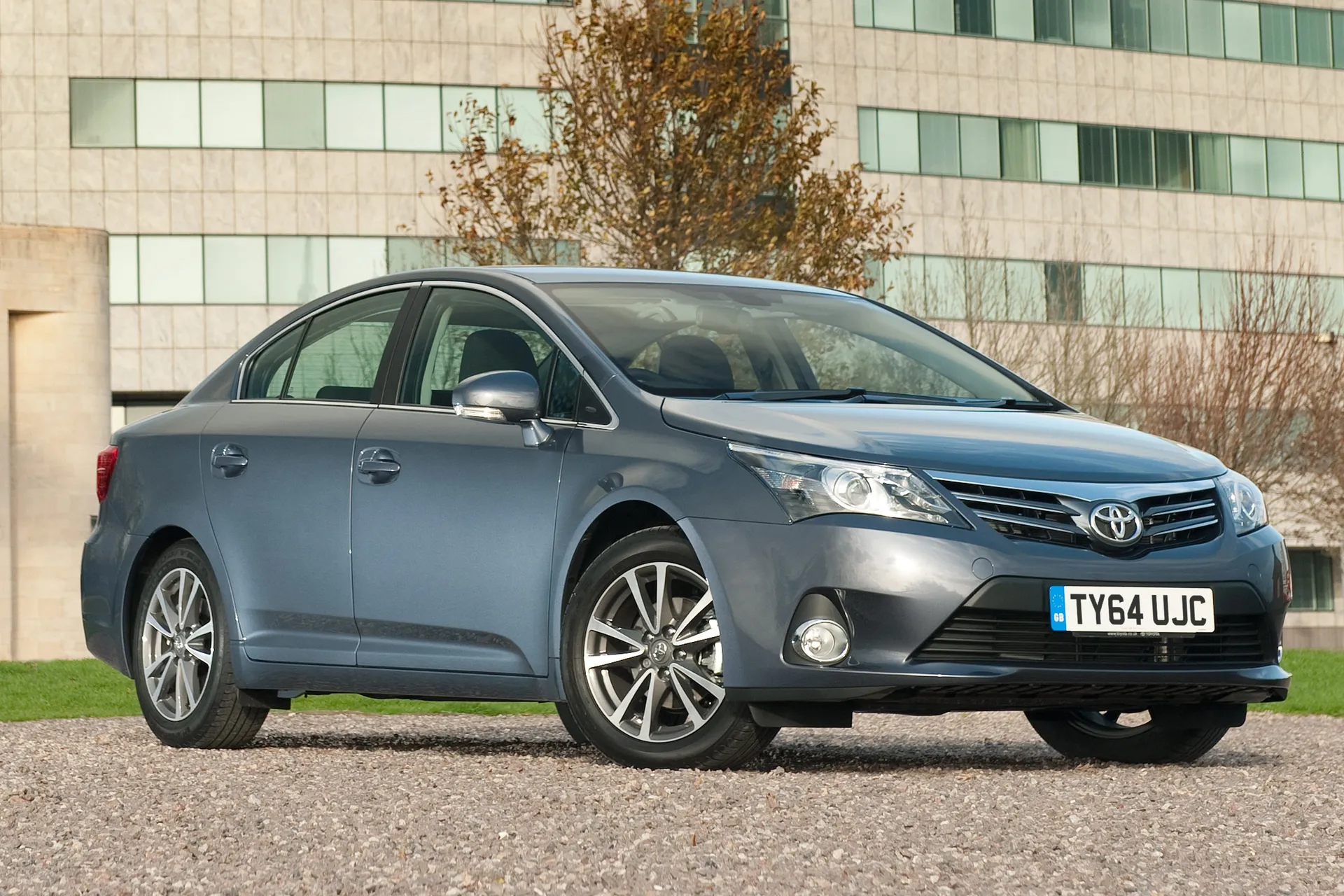
The Toyota Avensis comes in for a lot of stick for being a bit dull. Sure, it lacks excitement, but if you’re after a saloon or estate that will deliver years of loyal service, the Avensis is one of the best value cars you can buy.
Launched in 2009 and given a facelift in 2011, the British-built Toyota Avensis is a rival for the likes of the Ford Mondeo, Mazda 6, Honda Accord and Vauxhall Insignia. Like its key competitors, the Avensis was designed with company car drivers in mind, so it’s the vehicle of choice if you spend most of your time on the motorway.
There are a range of petrol and diesel engines to choose from, each one configured to deliver excellent fuel economy and tax-friendly CO2 emissions. The 2.0-litre D-4D diesel is a modern marvel, offering a terrific blend of performance and economy. With the caveat that you need to watch for potential diesel particulate filter (DPF) issues, it’s the engine we’d recommend.
We’d also say the TR trim – renamed Icon after March 2013 – delivers the best value for money, packing all the equipment you’ll ever need for a life on the motorway. That said, although the plush trim levels were expensive when new, they make more sense when you’re buying used.
Practicality is a real strong point. The cavernous boot in the Tourer (estate) is the practical hero, but you also get a generous amount of luggage capacity in the saloon, with the added benefit of folding rear seats.
Speaking of which, there’s room for three adults in the back, aided by the absence of a transmission tunnel, which creates a flat floor. Anyone sitting in the middle seat needn’t leave their feet and knees behind before travelling in an Avensis. Up front, there’s a large glovebox and a cavernous central storage bin, which is large enough for a handbag. There are also a couple of large door pockets and two cupholders, along with a ski hatch in the back seats.
Unfortunately, the interior is devoid of flair and imagination, especially if you opt for one of the lower trim levels. Adding leather helps to lift the mood, but the warm nickel and wood effect for the centre console feels like it has come straight out of the 1990s.
To drive, the Toyota Avensis is as dull as its reputation says, but although it can’t rival a Ford Mondeo for handling, it does offer a smooth and comfortable ride. You also have the reassurance of knowing that the Avensis is unlikely to go wrong. If it does, you’re backed by one of the best dealer networks in Europe.
Early examples cost less than a deposit on a new car, but we’d recommend a post-2011 car for the best Avensis experience. Leave your preconceptions at the door, because the Avensis is a surprisingly appealing car. You’ll need to get your kicks elsewhere, mind.
If you're looking for the newer version, you need our Toyota Avensis (2015-2019) review.
Is the Toyota Avensis right for you?
Flair, excitement, verve, desirability and panache. These are five things you won’t find in the Toyota Avensis. Instead, you get dependability, reliability, practicality, robustness and refinement.
The fact is, there are an awful lot of people who view a car on the same level as a dishwasher, washing machine or central heating system. There when you need it, but not given a second thought when it’s not. The practicality of the Avensis Tourer gives it the edge over the saloon, but both versions go about their business quietly and efficiently. If you’re after a car that will be cheap to run, dependable and safe, the Avensis is an excellent used buy.
What’s the best Toyota Avensis model/engine to choose?
We’d avoid the entry-level T2 trim, as it lacks the basic equipment we take for granted in 2020. The TR is arguably the range sweet-spot. It was designed with company car drivers in mind, so it packs a pretty decent level of standard equipment. The T4 and T Spirit were too expensive when the Avensis was new, but they make more sense on the used market.
Toyota renamed the trim levels in 2013, bringing the Avensis in line with the rest of the range. Active is best avoided, with the Icon offering the best value for money. Again, the Icon Plus and flagship Excel are better value now than when new.
As for the engine, there’s no need to look beyond the 2.0-litre D-4D diesel with a six-speed manual gearbox. It offers a terrific blend of performance and fuel economy. A Toyota Avensis saloon or Tourer with a 2.0 D-4D engine in TR or Icon trim would be our car of choice.
What other cars are similar to the Toyota Avensis?
Saloons and estate cars are facing a fight for survival as buyers turn to crossovers and SUVs in their droves. Which is a shame, because saloons and estates tend to be better to drive, while the wagons offer the kind of practicality an SUV can only dream of.
Chief rivals for the Avensis include the Ford Mondeo, Honda Accord and Mazda 6. Although it’s not as good to drive as the Mondeo and 6, it offers the same level of practicality and reliability as the Accord.
Because the Avensis is no longer available, we’d recommend the Toyota Camry if you’re after a Toyota saloon, or the Corolla Touring Sports if you require an estate.
Comfort and design
"The Avensis dashboard is straight out of the first chapter of car interior design. The layout is predictable: two dials ahead of the driver, four air vents, screen in the top half of the centre console, air conditioning controls in the lower half, and a large glovebox in front of the passenger."
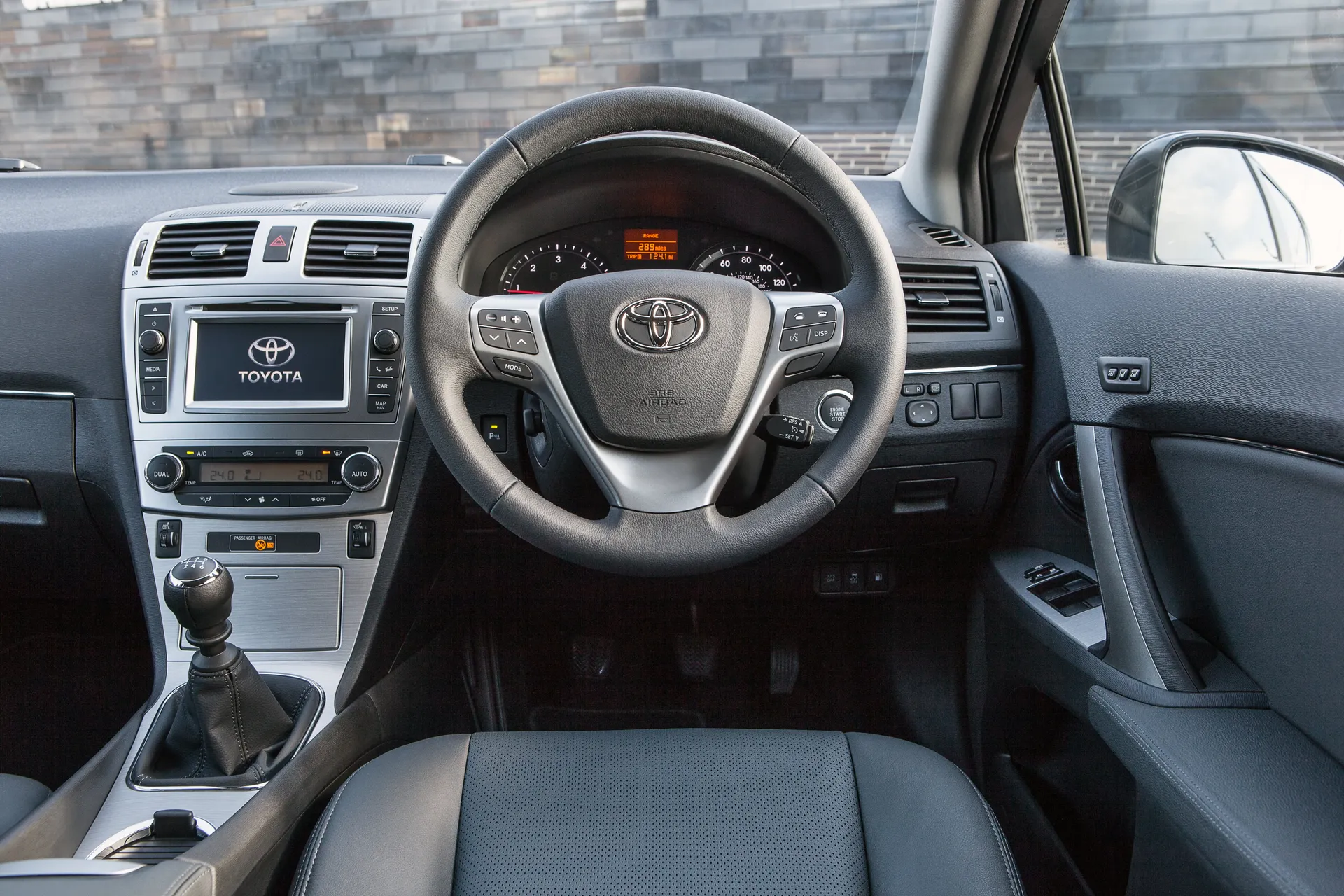
The Avensis dashboard is straight out of the first chapter of car interior design. The layout is predictable: two dials ahead of the driver, four air vents, screen in the top half of the centre console, air conditioning controls in the lower half, and a large glovebox in front of the passenger.
There’s nothing wrong with that. The layout is clear and functional, the design is easy on the eye, and – cliche alert – everything falls neatly to hand. Yes, it feels decidedly old-school, but if it ain’t broke, don’t fix it.
The Avensis was designed and developed for long motorway drives, which means the seats are comfortable and supportive, regardless of whether you opt for cloth or leather. Toyota gets the basics right.
Upgrading from the entry-level Avensis adds driver’s seat electric lumbar support to the mix, while higher trim levels boast heated front seats.
You might struggle to find an interior design that works for you. The lower trim levels are depressingly dull, with the dashboard, centre console and upper section of the doors swathed in grey. A nickel and wood effect centre console is available, but this jars with the shiny plastic and beige leather seats.
Perhaps we’re being unfair, because there’s a lot to be said for heater controls that are easy to use on the move, clear dials and a logical layout of buttons. It’s a comforting and stress-free cabin.
Quality and finish
If you’ll excuse the playground analogy, it’s a case of ‘swings and roundabouts’ when it comes to the quality and finish of the Toyota Avensis.
On the one hand, the scratchy plastics on the dashboard and doors leave a lot to be desired. They feel hollow and cheap to touch, creating a sense that you’re driving a volume car that’s just one step above the rental lot. But how many times do you touch the top of the dashboard? Once, maybe twice, when the dust gets deep enough to write ‘clean me’ with your fingers. Does it matter what it feels like? Arguably not.
The point is, everything feels robust and built to last. The Japanese favour longevity over the short-term gains delivered by soft-touch and expensive materials. The buttons and switches might lack the tactile qualities of a car with a premium badge, but they don’t feel cheap or nasty.
The doors shut with a reassuring thud, while the leather steering wheel, which became standard across the range in 2011, provides a good feeling of quality. The leather and Alcantara upholstery in the Icon Plus has a quality feel, but the jury is out on the luxuriousness of the nickel and wood-effect centre console. Fine in the 1990's, but not so great in 2020.
Infotainment
A decade is a long time in the world of in-car technology, which means early examples of the Toyota Avensis lack the kind of media systems we take for granted in 2020.
At launch, most versions came with a six-speaker audio system with radio, CD player and an AUX-in socket for MP3 players. There was no Bluetooth on the entry-level version, while satellite navigation could only be ordered as an expensive option.
Things improved in 2011, when the Avensis gained the Toyota Touch & Go multimedia and satellite navigation, along with the world debut of the advanced Toyota Touch & Go Plus system. The 6.1-inch infotainment screen was standard on all models except the T2, while the Touch & Go Plus was fitted to the T Spirit.
The standard Touch & Go features European mapping, live traffic information, speed limit and speed camera warnings, text messaging, Bluetooth, rear-view camera and audio streaming from iPods and other portable music players. Touch & Go Plus includes voice recognition, advanced traffic information, access to email and improved mapping.
Following the trim level restructuring in 2013, Touch & Go became standard on the Icon, while the Icon Plus and Excel featured Touch & Go Plus. In August 2013, Toyota launched the Avensis Edition, which also featured Touch & Go.
Space and practicality
Predictably, the Avensis Tourer is a practical hero, but both versions feature a generous amount of cabin space and a large boot. Indeed, there’s not a huge amount of difference in the space available when the rear seats are in use. The saloon offers 509 litres of luggage capacity, while the Avensis Tourer offers 543 litres. Obviously the space in the estate is more useful, helped in no small part by the large opening and additional height.
That said, the folding rear seats in the saloon create extra space if required, but this can’t compete with the 1,609 litres of capacity in the Tourer. Both models get a ski hatch in the rear seats.
The Tourer also boasts rails in the boot for securing loads (all except the entry-level versions), while the flush floor makes it easier to load heavy items. It’s not a class-leading luggage area, but the Avensis is an excellent load-lugger.
Things are even better in the cabin. Three adults can sit comfortably in the back, with the absence of a transmission tunnel meaning there’s plenty of leg- and knee-room for the centre seat.
This isn’t always the case in rival cars. Up front, there’s a huge glovebox, along with one of the largest central storage bins you’ll find in any car. It’s large enough for a bag, while the lid slides shut to provide a comfortable resting place for your arm. There’s also an exposed cupholder in the centre console, another one in the central storage bin, plus large door pockets in the front.
Handling and ride quality
"If you’ve been paying attention, you’ll know that the Toyota Avensis isn’t going to set many pulses racing when it comes to the driving experience. If anything, the Avensis has been engineered to lower your heart rate. Sit back and relax."
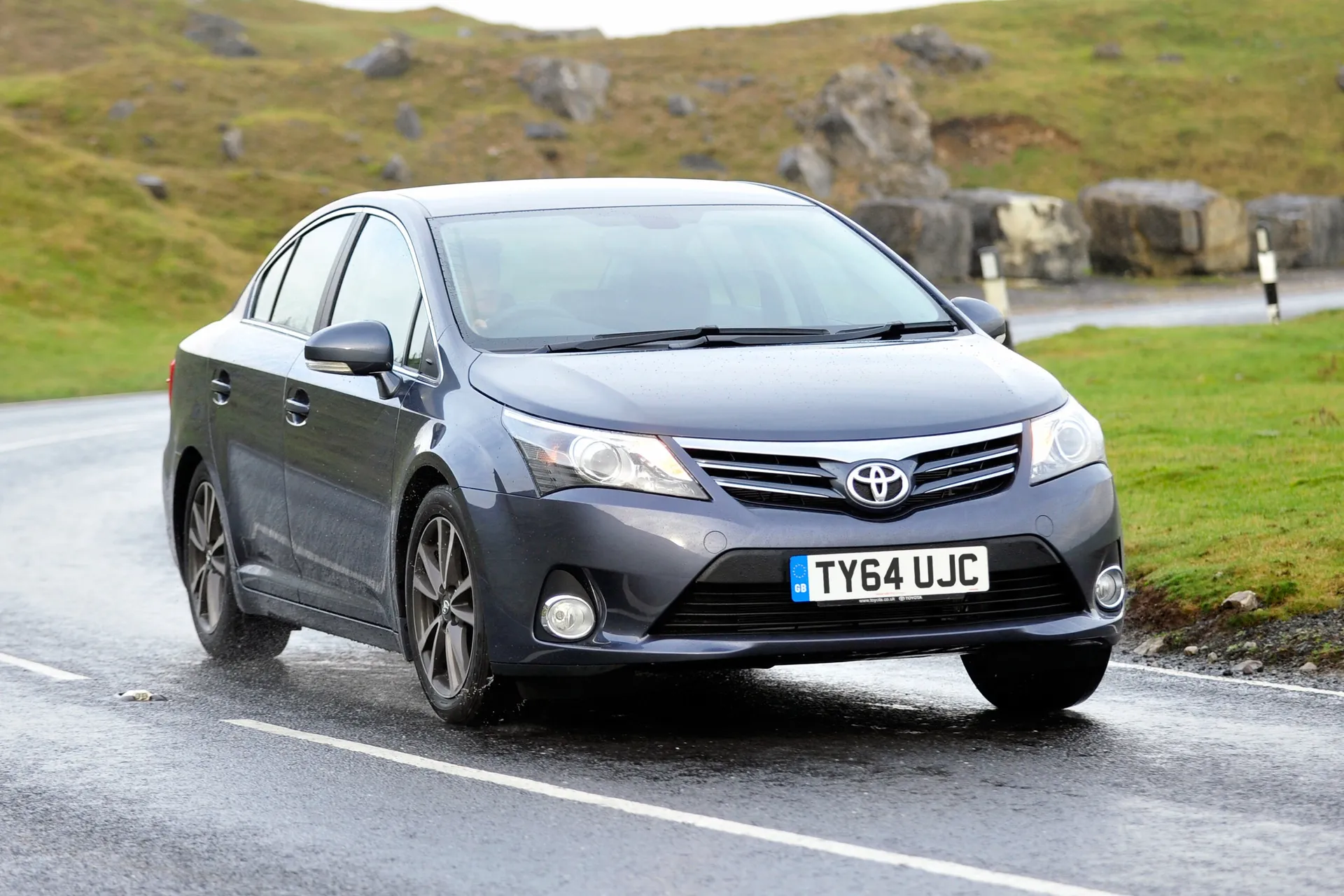
On a SWOT analysis, we’d list ride quality under ‘strengths’, but handling would be filed under ‘weaknesses’. Simple as that – business meeting over, clear the boardroom. Unfortunately, we have a word count to fill, so we’ll expand by doing a little blue sky thinking.
If the Avensis could choose a road, it would be a motorway. It feels at home on long, straight roads, where the comfortable seats and supple suspension rise to the fore. Beyond that, the Avensis begins to feel like a fish out of water.
The suspension will beg you for mercy if you corner with any degree of enthusiasm, while your passengers will beg you for a sickbag. Throw into the mix steering that’s devoid of feel, and a general numbness to the main controls, and you’ll soon learn to dial things back.
We won’t criticise the Avensis for this. In fact, we applaud Toyota for sticking to the basic principles that make the Avensis such a compelling company car. Too many manufacturers are guilty of trying to cater for all markets, which results in cars that are compromised in too many areas.
To stand any chance of enjoying yourself behind the wheel of an Avensis, buy a post-facelift version. Toyota tweaked the power steering to make it more direct, tuned the front and rear suspension and stiffened the body. The result is a car that’s a little better to drive, but not at the expense of ride comfort. In fact, Toyota worked on the aerodynamics, added extra insulation and changed the design of the front seats to make the cabin an even more pleasant place to be.
Engines and gearboxes
The 2.0-litre D-4D 130 diesel engine is the star of the Toyota Avensis range, especially following the 2011 facelift. Despite offering a 0-62mph time of sub-10 seconds, the engine delivers some remarkable economy figures.
It’s perfectly in-tune with the Avensis, offering plenty of mid-range punch for overtaking and when joining a motorway, but settling to a reasonably quiet idle at cruising speed.
The 2.2-litre D-CAT 150 diesel engine offers slightly improved performance at the expense of fuel economy. Fitted with a six-speed manual gearbox as standard, the D-CAT 150 could also be equipped with a six-speed automatic, making it Toyota’s first diesel automatic passenger car. In truth, the performance gains are so marginal, we’d stick with the 2.0 D-4D. Alternatively, the 2.2 D-CAT 180 sees the 0-62mph time drop to 8.5 seconds in the manual version, but we’re not sure the car needs that much poke.
A 1.6-litre Valvematic petrol engine was available at launch, but dropped from the range in 2011. A 0-62mph time of 10.1 seconds and a top speed of 125mph was comparable with the 2.0 D-4D on paper, but it lacked the easygoing torque of the diesel.
The 1.8-litre Valvematic offered a small performance gain over the 1.6-litre version, but could be equipped with a power-sapping and frustrating CVT transmission. It added a second to the 9.1 seconds the manual version took to reach 62mph, while taking a chunk out of the fuel economy.
A 2.0-litre Valvematic completes the engine range. Once again, it could be ordered with a CVT transmission, but the six-speed manual is better.
Refinement and noise levels
It would be a stretch to say that the Avensis offers luxury levels of refinement, but it’s clear that Toyota has used its experience with Lexus to great effect.
That said, the diesel engines, while efficient and punchy, lack the refinement of the diesels you’ll find in rival Volkswagen Group cars, especially when pressed hard. Leave an Avensis diesel idling outside your house and your neighbours will think you’ve opened a taxi cab business.
There’s a fair amount of road noise in all versions, especially the pre-facelift cars, and some wind noise at motorway speeds.
Although Toyota’s CVT transmission is better than some units, it’s too noisy when you surprise it with a sudden press of the accelerator pedal, and it can be a little slow to react. Fortunately, you can override it with manual inputs, but that kind of defeats the object of the transmission.
Our recommendation is to adopt a relaxed stance in any version of the Avensis. As an aside, we’d also point to the fact that the Avensis tends to perform well in reliability studies, which should provide some peace of mind when buying a used car.
Safety equipment
The Toyota Avensis was ranked number five of the 30 cars tested by Euro NCAP in 2009, finishing ahead of the Volvo XC60. The five-star rating applies to the saloon and the Tourer. The individual ratings were: 90% for adult occupant protection, 86% for child occupant protection, 53% for pedestrian safety, and 86% for safety assist systems.
At launch, the Avensis was fitted with driver and front passenger airbags, front side airbags, driver’s knee airbag, full-length curtain shield airbags, Isofix mounts on the rear seats, steering assist vehicle stability control and brake assist.
All models feature front seat headrests that reduce the risk of whiplash by moving forwards and up to support the head in the event of a rear-end collision. The 2.2 D-CAT 150 T Spirit with an automatic transmission also featured an optional pre-crash safety system with pre-crash warning, adaptive cruise control, lane-keep assist and lane-departure warning. This was an advanced package for the time.
Options include bi-xenon headlights that monitor the speed and steering wheel rotation to predict the area in front of the vehicle that needs illumination.
MPG and fuel costs
"At launch, the most economical Toyota Avensis was the 2.0-litre D-4D 130 saloon, with a claimed 55.4mpg. This dropped to 54.3mpg in the Tourer."
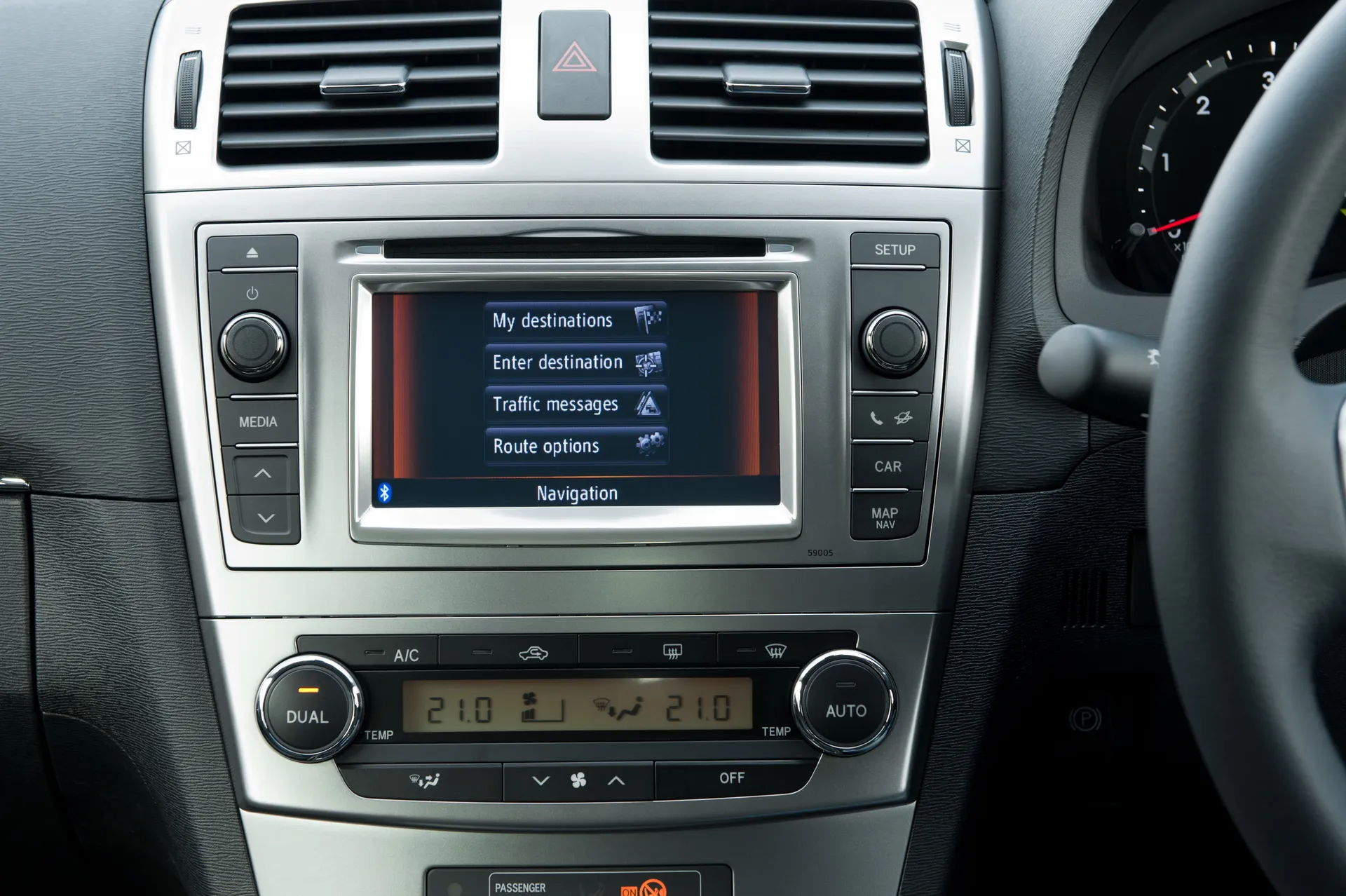
The fitment of a diesel particulate filter (DPF) in June 2010 resulted in the fuel consumption increasing to 53.3mpg in the saloon. The 2.2-litre D-4D 150 is another efficient engine, offering a claimed 51.4mpg in the saloon and 50.4mpg in the saloon. Other engines range from 40.4mpg to 47.9mpg, depending on the bodystyle.
The 2.0-litre D-4D diesel was revised for the 2011 facelift. Fuel economy increased to 62.8mpg (saloon), while CO2 emissions dropped to 119g/km.
Insurance groups and costs
Insurance groups for the Toyota Avensis saloon range from eight to 26, which means cover should be reasonably affordable. The Toyota Avensis Tourer should cost roughly the same to insure, but although the lowest group rating is 15, the groups go up to 28. With a group rating of eight, the entry-level 1.6-litre diesel Active should cost no more to insure than a city car or hatchback.
For some context, the current Ford Mondeo, introduced in 2014, has a group rating of 21 to 33. The current Mazda 6 (saloon and estate) is rated at 16 to 31.
VED car tax
The rate of Vehicle Excise Duty (VED, or road tax) for the pre-facelift Avensis ranges from £150 to £240 depending on the engine. For example, the 2.0-litre D-4D emits just 134g/km, which puts it into tax band E (£150). Meanwhile, the 2.2-litre D-CAT 150 with a six-speed automatic transmission emits 169g/km, placing it in band H (£240).
Post-facelift cars tend to be cheaper to tax. For example, revisions to the 2.0-litre D-4D diesel engine resulted in the CO2 emissions dropping to 119g/km. This puts in tax band C, which means an annual VED rate of just £30.
How much should you be paying for a used Toyota Avensis?
"You can buy a 2009 Toyota Avensis saloon or estate for as little as £1,000. For this money, you can expect an intergalactic mileage, an interior that looks and smells like a teenager’s bedroom, along with evidence of life as a taxi cab."
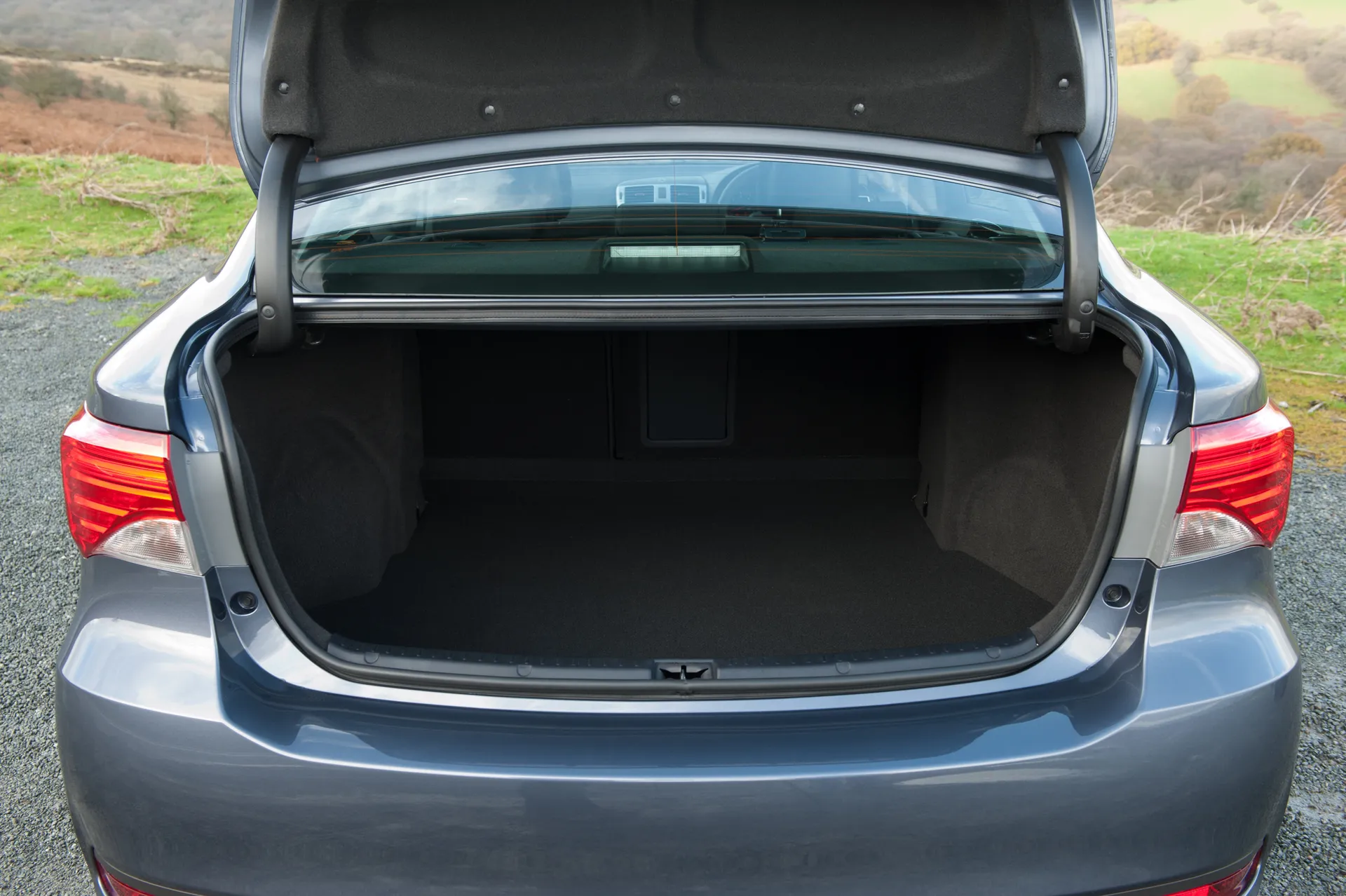
In fact, the majority of Avensis models available for less than £2000 have between 100,000 and 200,000 miles on the clock, some with even more. This highlights the reliability and dependability you can expect from an Avensis.
You’ll need to find at least £4000 for the revised version, but prices vary wildly. For example, a pre-facelift model with a good specification and low miles will probably be more expensive than a facelift version with loads of miles on the clock. Make sure you find one with full Toyota service history, ideally with one or two previous owners.
Trim levels and standard equipment
The entry-level T2 trim (later Active) launched in 2009 with air conditioning, a six-speaker audio system with CD player, electric front windows and seven airbags. In 2011, the T2 trim was upgraded to include Bluetooth, daytime running lights, new interior trims and a leather steering wheel.
TR (later Icon) launched with 17-inch alloy wheels, front fog lights, automatic air conditioning, audio system with Bluetooth and an aux-in socket, cruise control (not the 1.8 with Multidrive S), automatic headlights and wipers, driver’s seat lumbar support, leather steering wheel with audio controls, leather gear knob, a titanium centre console finish, electric rear windows and, on the Tourer, rails in the boot.
The TR was upgraded in 2011 to include Toyota Touch & Go, satellite navigation, a rear-view camera, an auto-dimming rear-view mirror, plus smart entry and start on the 2.2 D-CAT automatic.
T4 (later Icon Plus) and T Spirit (later Excel) offer more equipment and cosmetic upgrades. In 2013, Toyota launched an Avensis Select, which was based on the Active, plus an Avensis Edition, which was based on the Icon.
Get our latest advice, news and offers
Keep me updated by email with the latest advice, news and offers from heycar.
By submitting you agree to our privacy policy



